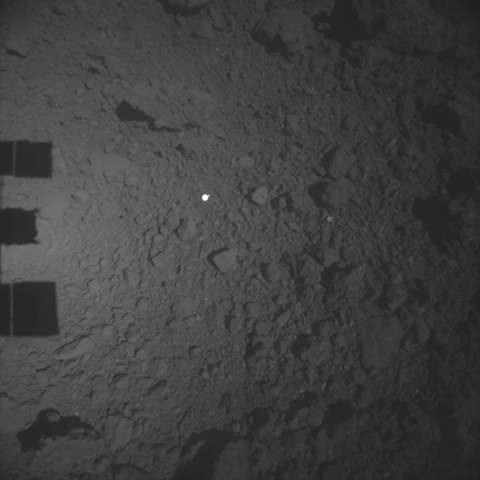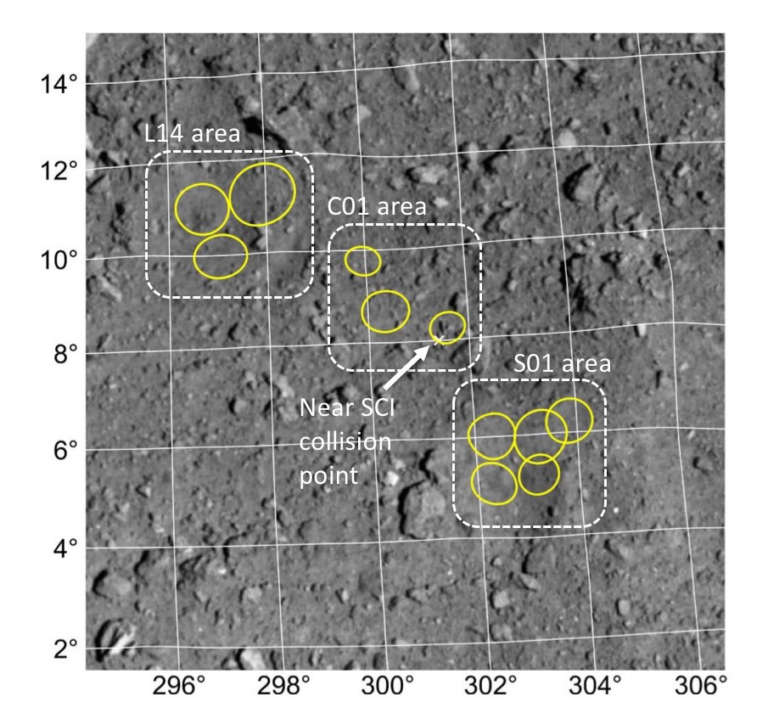Jason Davis • Jun 04, 2019
Hayabusa2 drops second target marker, targets artificial crater for sample collection
Japan's Hayabusa2 spacecraft has successfully dropped a second target marker on Ryugu. The reflective softball-sized sphere, which contains the names of Planetary Society members and other supporters, will give the spacecraft a visual guide if mission planners send it back to the surface to attempt a second sample collection.
JAXA is now considering collecting the sample directly from the area where Hayabusa2 created an artificial crater in early April, thanks to updated imagery collected during an aborted touchdown marker drop attempt in mid-May.
Hayabusa2, Japan's mission to Ryugu and other asteroids
Japan's Hayabusa2 spacecraft returned a sample from asteroid Ryugu to Earth in December 2020.
In my previous update, I described how Hayabusa2 automatically halted its first target marker drop attempt when it was just 50 meters above the surface. A recently translated JAXA press briefing says the abort happened after Hayabusa2's LIDAR suddenly reported the spacecraft was much higher than it should be.
The sensitivity of Hayabusa2's LIDAR must be adjusted on a case-by-case basis for a wide variety of conditions around Ryugu. The spacecraft can automatically do this on the fly, but on 16 May, some "noise data" got factored into the adjustment and knocked the LIDAR out of calibration. Upon noticing an altitude discrepancy, Hayabusa2 immediately backed itself away from the surface.
I'm not entirely sure what "noise data" means, but Ryugu is very dark, which messes with the LIDAR and caused a similar glitch last year. In any case, JAXA says they "found [an] adjustment method that could reliably prevent noise mixing. This will be adopted from now on." With this fix in hand, Hayabusa2 descended to Ryugu on 30 May for a second try, and this time, it was successful!

In my last update I also noted that JAXA was considering collecting the second sample from a region called S01, which is close to, but still a few tens of meters away from the artificial crater Hayabusa2 created using its copper impactor. Scientists believed that a sample from S01 should still contain some subsurface Ryugu material excavated during the impact. Here's a handy map:

But wait—why wouldn't they sample directly from the crater itself, to guarantee they get some subsurface material? The reason was that the terrain in that area looked a little too dicey to bring the spacecraft, which spans 6 meters across its solar panels, in for a touchdown.
However, during the aborted touchdown operation on 16 May, mission managers collected some new up-close imagery of the area around the crater, and decided they might be able to sample from it after all! Here's a panorama I made using 2 of the new images Hayabusa2 captured in that area:

The team liked what they were seeing well enough to drop the second target marker directly in C01, an area that includes the artificial crater:
While the target marker could not be dropped during the PPTD-TM1 operation, we were able to image around the artificial crater at low altitude. As a result, the "PPTD-TM1A" operation will drop a target marker in the CO1 area between May 28 - 30. https://t.co/i7f106Yblb pic.twitter.com/UJlw16hgxh
— HAYABUSA2@JAXA (@haya2e_jaxa) May 27, 2019
So what happens now? JAXA’s latest press briefing says they will make a decision on whether to proceed with a second sampling by mid-June. The touchdown itself would be performed "between the end of June and start of July." As I explained in my last update, Hayabusa2 is almost out of time to collect a second sample, because Ryugu is approaching perihelion, which is causing the asteroid’s surface temperature to rise. JAXA now says they have until late July to collect a sample; that's a couple weeks longer than their previous estimates.
Let’s Go Beyond The Horizon
Every success in space exploration is the result of the community of space enthusiasts, like you, who believe it is important. You can help usher in the next great era of space exploration with your gift today.
Donate Today

 Explore Worlds
Explore Worlds Find Life
Find Life Defend Earth
Defend Earth


